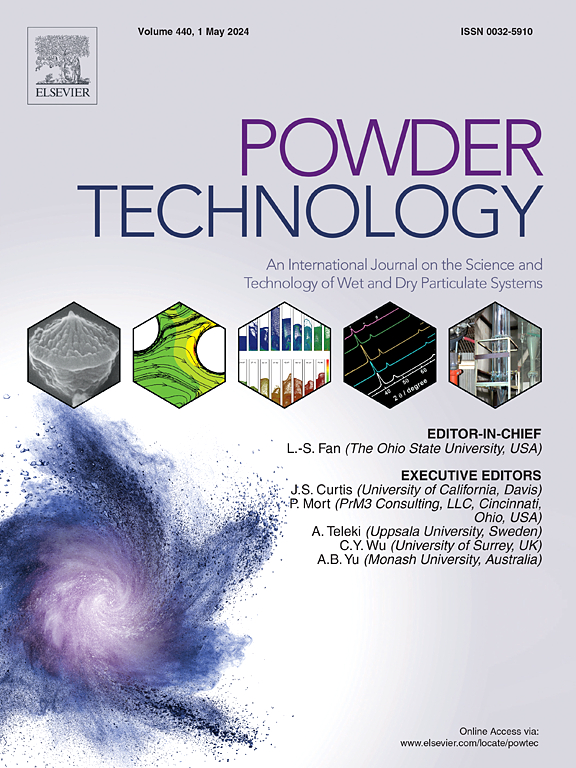Investigation on spreading behavior and influencing parameters of particle-droplet collision
IF 4.5
2区 工程技术
Q2 ENGINEERING, CHEMICAL
引用次数: 0
Abstract
This paper investigated the dynamic wetting characteristics during droplet impact on spherical particle as the main monitoring object, and analyzed the effects of droplet impact velocity, and surface tension on droplet spreading coefficient (Dc) and particle force. The droplet-particle collision condensation test platform designed and constructed in this paper. In addition, a novel particle-droplet collision numerical model was constructed by combining VOF, dynamic mesh and mesh adaptation techniques to assist the research. The results shown that the rate of increase of Dc increased with the increase of the collision velocity. When the collision velocity was less than 1 m/s, the attraction force generated by droplet on particle was greater than the resistance generated by surface tension, which results in adsorption force. The resistance of droplet to particle increased with the increase of velocity, while the effect of adsorption decreased. When the collision velocity exceeded 1 m/s, the effect of adsorption force was negligible, the particle and droplet could not produce adsorption mode of bonding and need to overcome the surface tension for wrapping. Reducing the surface tension could increase the encapsulation speed of the droplet to the particle, for example, the droplet with a surface tension of 28mN/m took only half as long as the surface tension of 76mN/m. The results of this study provide a basic theoretical basis for further exploration of the particle-droplet collision and coalescence mechanism.

求助全文
约1分钟内获得全文
求助全文
来源期刊

Powder Technology
工程技术-工程:化工
CiteScore
9.90
自引率
15.40%
发文量
1047
审稿时长
46 days
期刊介绍:
Powder Technology is an International Journal on the Science and Technology of Wet and Dry Particulate Systems. Powder Technology publishes papers on all aspects of the formation of particles and their characterisation and on the study of systems containing particulate solids. No limitation is imposed on the size of the particles, which may range from nanometre scale, as in pigments or aerosols, to that of mined or quarried materials. The following list of topics is not intended to be comprehensive, but rather to indicate typical subjects which fall within the scope of the journal's interests:
Formation and synthesis of particles by precipitation and other methods.
Modification of particles by agglomeration, coating, comminution and attrition.
Characterisation of the size, shape, surface area, pore structure and strength of particles and agglomerates (including the origins and effects of inter particle forces).
Packing, failure, flow and permeability of assemblies of particles.
Particle-particle interactions and suspension rheology.
Handling and processing operations such as slurry flow, fluidization, pneumatic conveying.
Interactions between particles and their environment, including delivery of particulate products to the body.
Applications of particle technology in production of pharmaceuticals, chemicals, foods, pigments, structural, and functional materials and in environmental and energy related matters.
For materials-oriented contributions we are looking for articles revealing the effect of particle/powder characteristics (size, morphology and composition, in that order) on material performance or functionality and, ideally, comparison to any industrial standard.
 求助内容:
求助内容: 应助结果提醒方式:
应助结果提醒方式:


